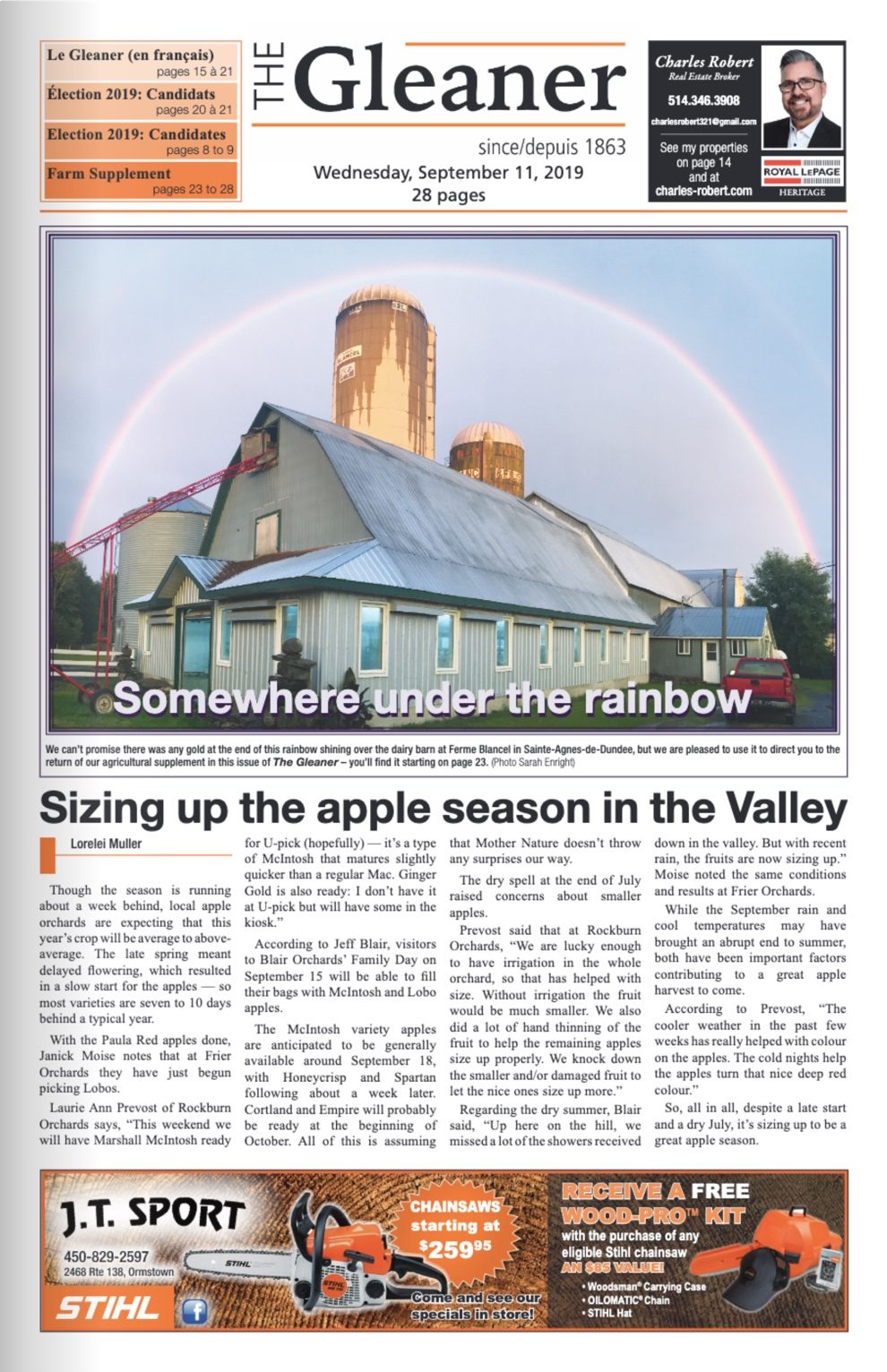
Editor’s note: While it was very welcome news when the IRS allowed The Salt Lake Tribune to become a nonprofit, realistically, most metro papers aren’t likely to be interested in such a shift. They’re owned by large chains, most of them publicly traded, and giving away significant assets doesn’t come naturally.
The greater potential area of impact could well be in smaller community newspapers, more of whom have maintained local ownership and strong local ties. One example of such a transfer is in Quebec, where when a newspaper seemed fated to disappear, its owners instead donated it to a newly formed community foundation. Here, Karen Longwell of the Ryerson Review of Journalism tells the story.
More than 250 media outlets closed across Canada from 2008 to 2019, according to a 2019 study by the Local News Research Project. A small Quebec paper, The Gleaner, nearly joined them.
Established in 1863, The Gleaner serves a string of rural communities in the Chateauguay Valley, west of Montreal, sandwiched by the St. Lawrence River to the north and the U.S. border to the south. The population is approximately 46,000, with about 26,570 French-speaking residents and 13,765 English-speaking residents, according to the 2011 census.
Instead of closing The Gleaner in November 2018, the English-language newspaper’s owner, Gravité Média, reached out to Stéphane Billette, the local National Assembly of Quebec member at the time. Gravité asked if the community once served by The Gleaner would like to own the paper’s rights, said Hugh Maynard, the chairperson of The Gleaner’s steering committee.
Billette contacted Maynard, who then called a public meeting, inviting the Chateauguay Valley community through email, word of mouth, and Facebook. Nearly 40 people attended the meeting and the non-profit organization Chateauguay Valley Community Information Services (CVCIS) was formed with Maynard as the executive director. Gravité Média sold the newspaper rights to CVCIS; as a symbolic gesture, CVCIS paid $1.
An 11-member steering committee got to work publishing the paper again. The committee consisted of former Gleaner journalists and editors, along with a retired secretary, an artist, a cartoonist, a retired teacher, a website designer, and a farmer. Many of the community volunteers had some background in media but several had no journalism experience, said Chantal Hortop, a former editor of The Gleaner.
“We had a number of people who stepped in due to their value of the newspaper rather than having any experience working in communications or journalism,” Hortop said. “They just felt strongly that The Gleaner had to keep going, and if there was a way to do it with community effort, we were going to make it happen.”
Like many publications across Canada, The Gleaner had been passed from media chain to media chain following a series of mergers and acquisitions. Until 1985, the publication was a proudly locally owned newspaper. But since its sale to Quebec-based media chain Les Hebdos Montérégiens, the publication has been moved between competing companies. The paper was sold to Quebecor in 2011 then Transcontinental in 2013. In 2015, The Gleaner became an eight-page insert in the free French-language weekly Journal le Saint-François. In 2017, when Journal le Saint-François was sold to the regional media company Gravité Média, The Gleaner’s eight-page insert went with it.
On June 5, The Gleaner re-launched with the first print edition since it was sold to CVCIS, printing 5,000 copies. Volunteers handed out the revived paper from a booth at the Huntingdon Fair, said Lorelei Muller, a committee member and former nonprofit executive director.
@KellyGreig Join Us for the Official Relaunch of The Gleaner
Wednesday, June 5, 2019 at 16h30
Salle Culturelle Alfred-Langevin, MRC Building, 10 rue King, Huntingdon, Quebec J0S 1H0More information:
Hugh Maynard
Interim Executive Director, CVCIS
maynardhugh@gmail.com— Qu'anglo (@TheQuangloAngle) May 29, 2019
The reaction to The Gleaner’s re-emergence has been positive, she said. “I have seen more than one person hug the newspaper,” Muller said. “It is our valley news. It is what connects us. If something big happens in the area, sure CTV or CBC or whoever is going to cover something big, but they don’t have our day-to-day stuff, our regular community news.”
Coverage of the local candidates running in the federal election was particularly important for the community, Hortop said. The paper ran a two-page election spread in the September edition.
For Cathy MacFarlane Dunn, 68, The Gleaner has been a part of her life since she could read it, starting at around 6 years old. A few years ago, after The Gleaner became part of the Journal le Saint-François, Dunn returned from a summer away in Texas. She’d been visiting her daughter and hadn’t kept up with the news at home online or by phone. Soon after she returned, she ran into an acquaintance and asked how her parents were doing.
Dunn said her friend “just went white,” explaining that her parents had been killed in a car crash a month prior. Dunn hadn’t heard the news. “I just felt terrible,” she said. The loss of the local paper meant she didn’t hear about deaths, births, weddings, or community events.
“The Gleaner was the link that kept us all connected. So I am thoroughly over the moon with excitement that it is coming back,” Dunn said.

Since that first edition, the volunteers published further issues in August and September. On October 9, they formalized the nonprofit organization and elected a board of directors, Maynard said.
In those first three editions, members of the steering committee took on several roles to get the paper out. With experience in the nonprofit world, Muller took on administrative tasks as well as selling ads and writing stories. She has some experience writing promotional copy, but no background in journalism. Volunteers with journalism experience — Sarah Rennie and Emily Southwood — made sure the stories were polished. (“I have a tendency to bury the lede,” Muller said.)
The new board of directors will formulate a plan for more serious issues such as complaints or libel. The team also hopes that contributors will be paid for their work going forward.
“It is becoming more clear that this cannot continue as a completely volunteer endeavor,” Muller said. Hortop, for example, spent a week laying out the paper. But advertising and community fundraising has covered printing costs with funds left over, which should make payment possible, Muller said.
There are similar nonprofit community news models in Canada, said John Hinds, president of News Media Canada. Employees bought the Prince Albert Daily Herald in Saskatchewan in 2017. La Presse in Quebec is owned by a social trust and operates with a nonprofit model.
“It is certainly a trend we are seeing,” Hinds said. “I think The Gleaner is the most advanced in terms of really getting that community ownership model going.”
The board’s next steps are to facilitate The Gleaner moving to biweekly printing starting in January, along with weekly updates online. The main challenge: securing 1,500 paid subscribers to be able to move forward with this plan, Maynard said. Once the paper is up and running, the board will work towards expanding the paper’s financial model.
In the past, many small town newspapers ran printing presses and generated revenue from advertising sales, Maynard said. This is no longer the case. “The golden days of newspapers are gone.”
When asked if he thinks The Gleaner model is sustainable, Maynard is cautiously optimistic. “Ask me in a year: Did we make it?”
Karen Longwell is the visual editor at the Ryerson Review of Journalism, where this piece was first published, and a graduate student at the Ryerson University School of Journalism in Toronto.